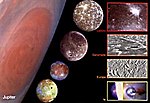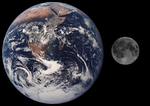A natural satellite or moon is a celestial body that orbits a planet or smaller body, which is called the primary. Technically, the term natural satellite could refer to a planet orbiting a star, or a dwarf galaxy orbiting a major galaxy, but it is normally synonymous with moon and used to identify non-artificial satellites of planets, dwarf planets, and minor planets.
Two hundred and forty bodies, all in the Solar System, are formally classified as moons. They include 165 orbiting the eight planets,[1] 6 orbiting dwarf planets, and dozens more orbiting small solar system bodies. 150 additional small bodies have been observed within Saturn's ring system, but they were not tracked long enough to establish orbits. Other stars and their planets are very likely to have natural satellites, although none have yet been observed.
The large gas giants have extensive systems of moons, including half a dozen comparable in size to Earth's moon: the four Galilean moons, Saturn's Titan, and Neptune's Triton. Saturn has an additional six mid-sized moons massive enough to have achieved hydrostatic equilibrium, and Uranus has five. Of the inner planets, Mercury and Venus have no moons at all; Earth has one large moon (the Moon); and Mars has two tiny moons, Phobos and Deimos.
Among the dwarf planets, Ceres has no moons (though many objects in the asteroid belt do). Pluto has three known satellites, the rather large Charon and the smaller Nix and Hydra. Haumea has two moons, and Eris has one. The Pluto-Charon system is unusual in that the center of mass lies in open space between the two, a characteristic of a double planet syst
Origin
The natural satellites orbiting relatively close to the planet on prograde orbits (regular satellites) are generally believed to have been formed out of the same collapsing region of the protoplanetary disk that gave rise to its primary. In contrast, irregular satellites (generally orbiting on distant, inclined, eccentric and/or retrograde orbits) are thought to be captured asteroids possibly further fragmented by collisions. The Earth's Moon[2] and possibly Charon[3] are exceptions among large bodies in that they are believed to have originated by the collision of two large proto-planetary objects (see the giant impact hypothesis). The material that would have been placed in orbit around the central body is predicted to have reaccreted to form one or more orbiting moons. As opposed to planetary-sized bodies, asteroid moons are thought to commonly form by this process. Triton is another exception, which although large and in a close, circular orbit, is thought to be a captured dwarf planet.
[edit] Geological activity
Of the nineteen known moons massive enough to have lapsed into hydrostatic equilibrium, several remain geologically active today. Io is the most volcanically active body in the Solar System, while Triton and Enceledus have geysers. Titan and Triton have significant atmospheres; Titan also has methane lakes, and presumably rain. Four of the largest moons, Europa, Ganymede, Callisto, and Titan, are thought to have subsurface oceans of liquid water, while smaller Enceladus may have localized subsurface water. Many other moons, such as Tethys, show evidence of past geological activity. In these cases, the geological activity comes mainly from the tidal heating from orbiting their gas giant primaries.
[edit] Orbital characteristics
[edit] Tidal locking
The regular natural satellites in the solar system are tidally locked to their primaries, meaning that the same side of the moon always faces the planet. The only known exception is Saturn's moon Hyperion, which rotates chaotically because of the gravitational influence of Titan.
In contrast, the outer moons of the gas giants (irregular satellites) are too far away to have become locked. For example, Jupiter's moon Himalia, Saturn's moon Phoebe, and Neptune's moon Nereid have rotation period in the range of ten hours, while their orbital periods are hundreds of days.
[edit] Satellites of satellites
No moons of moons (natural satellites that orbit the natural satellite of another body) are known. In most cases, the tidal effects of the primary would make such a system unstable.
However, calculations performed after the recent detection [4] of a possible ring system around Saturn's moon Rhea indicate that Rhean orbits would be stable. Furthermore, the suspected rings are thought to be narrow,[5] a phenomenon normally associated with shepherd moons.
[edit] Trojan satellites
Two moons are known to have small companions at their L4 and L5 Lagrangian points, sixty degrees ahead and behind the body in its orbit. These companions are called Trojan moons, as their orbits are analogous to the Trojan asteroids of Jupiter. The Trojan moons are Telesto and Calypso, which are the leading and following companions respectively of Tethys; and Helene and Polydeuces, the leading and following companions of Dione.
[edit] Asteroid satellites
The discovery of 243 Ida's moon Dactyl in the early 1990s confirmed that some asteroids have moons; indeed, 87 Sylvia has two. Some, such as 90 Antiope, are double asteroids with two comparably sized components.
[edit] Natural satellites of the Solar System
The largest natural satellites in the Solar System (those bigger than about 3000 km across) are Earth's moon, Jupiter's Galilean moons (Io, Europa, Ganymede, and Callisto), Saturn's moon Titan, and Neptune's captured moon Triton. For smaller moons see the articles on the appropriate planet. In addition to the moons of the various planets there are also over 80 known moons of the dwarf planets, asteroids and other small solar system bodies. Some studies estimate that up to 15% of all trans-Neptunian objects could have satellites.
The following is a comparative table classifying the moons of the solar system by diameter. The column on the right includes some notable planets, dwarf planets, asteroids, and Trans-Neptunian Objects for comparison. The moons of the planets are named after mythological figures. These are predominately Greek, except for the Uranian moons, which are named after Shakespearean characters. The nineteen bodies massive enough to have achieved hydrostatic equilibrium are in bold in the chart below and labeled on the chart at right, though a few of the smaller ones are not visible at the scale of the chart. Minor planets suspected but not proven to have achieved a hydrostatic equilibrium are italicized in the table below.
[edit] Terminology
The first known natural satellite was the Moon (luna in Latin). Until the discovery of the Galilean satellites in 1610, however, there was no opportunity for referring to such objects as a class. Galileo chose to refer to his discoveries as Planetæ ("planets"), but later discoverers chose other terms to distinguish them from the objects they orbited.
Christiaan Huygens, the discoverer of Titan, was the first to use the term moon for such objects, calling Titan Luna Saturni or Luna Saturnia – "Saturn's moon" or "The Saturnian moon", because it stood in the same relation to Saturn as the Moon did to the Earth.
As additional moons of Saturn were discovered, however, this term was abandoned. Giovanni Domenico Cassini sometimes referred to his discoveries as planètes in French, but more often as satellites, using a term derived from the Latin satelles, meaning "guard", "attendant", or "companion", because the satellites accompanied their primary planet in their journey through the heavens.
The term satellite thus became the normal one for referring to an object orbiting a planet, as it avoided the ambiguity of "moon". In 1957, however, the launching of the artificial object Sputnik created a need for new terminology. The terms man-made satellite or artificial moon were very quickly abandoned in favor of the simpler satellite, and as a consequence, the term has come to be linked primarily with artificial objects flown in space – including, sometimes, even those which are not in orbit around a planet.
As a consequence of this shift in meaning, the term moon, which had continued to be used in a generic sense in works of popular science and in fiction, has regained respectability and is now used interchangeably with satellite, even in scientific articles. When it is necessary to avoid both the ambiguity of confusion with the Earth's moon on the one hand, and artificial satellites on the other, the term natural satellite (using "natural" in a sense opposed to "artificial") is used.
[edit] The definition of a moon

There is no established lower limit on what should be considered a moon. Every body with an identified orbit, some as small as a kilometer across, has been identified as a moon, though objects a tenth that size within Saturn's rings, which have not been directly observed, have been called moonlets. Small asteroid moons, such as Dactyl, have also been called moonlets.
The upper limit is also vague. When the masses of two orbiting bodies are similar enough that one cannot be said to orbit the other, they are described as a double body rather than primary and satellite. Asteroids such as 90 Antiope are considered double asteroids, but they have not forced a clear definition as to what constitutes a moon. Some authors consider the Pluto-Charon system to be a double (dwarf) planet. The most common dividing line on what is considered a moon rests upon whether the barycentre is below the surface of the larger body, though this is somewhat arbitrary, as it relies on distance as well as relative mass.
em.





